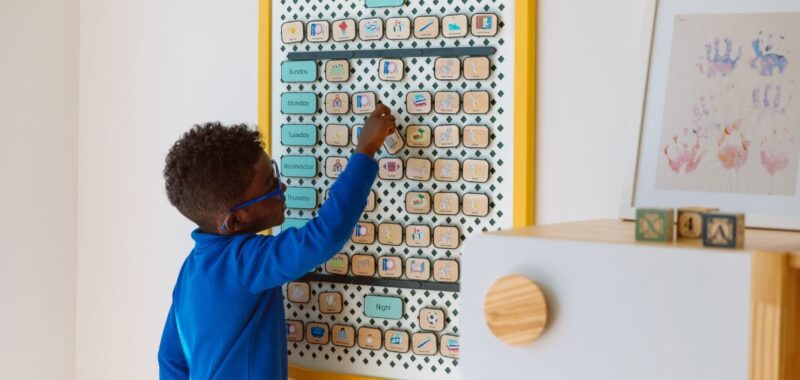When kids know what’s coming, everyone can breathe a little easier. That’s the primary sentiment behind Charmspring, a new children’s brand co-founded by Steph Korey Goodwin, who is also the co-founder of Away, and Jennie Monness, also the co-founder of Union Square Play. The key to that family harmony? Established routines. The brand launches today with their first product, the Springboard, a beautiful, streamlined and, importantly, very kid-friendly routine board that helps even the littlest family members take ownership of their daily schedule.

With four kids under 6 between them, Korey Goodwin and Monness deeply understand the importance of routines and fostering independence. “We noticed that when our children understood their routines, they felt more secure and engaged overall,” the founders tell Motherly. When they couldn’t find a process that worked well for them, they got to work building their own—sparking the idea for Charmspring.
I jumped at the chance to test out the Springboard with my two boys, ages 6 and 8, who definitely thrive on a set routine—and I’m thrilled to report it’s exactly what I’ve been looking for. That’s for two primary reasons: the chic design means I’m actually happy to have it on display in my home (no more fridge-door clutter!), giving it pride of place and making sure it’s easy for my kiddos to reach. And secondly, the personalized boards come with magnetic, clickable tiles that are both interactive and satisfying to pop in, which means my kids are happy to move them around and even set up their own after-school routines—giving them more control over their schedule, while also helping them understand what’s expected of them.


After they hop off the school bus, I often have to ask my kids ad nauseum to put away their sneakers, unpack their backpacks and wash their hands before having a snack—and soon after, it’s homework time. Now, having those expectations visually displayed means less friction and frustration for all of us. On Saturday morning, we swap the daily am/pm schedule for a list of weekend chores, which lets the kids consult their Springboard and move a task from “to-do” to “done”—all without constant reminders and prodding.
Clearly setting expectations in advance helps establish those regular routines—and reduce potential battles.
My husband and I have tried a slew of iterations on the chore chart for our family: over-designed paper printouts, hand-written to-do lists, personalized clipboards, dry-erase boards; the list goes on. None have had much staying power—or much buy-in from our kiddos—and they all felt pretty work-intensive on the parents’ part.
But that’s the beauty of the Springboard: the bulk of the work is already done—and beautifully crafted, with cute, illustrated tiles outlining daily activities (everything from brushing teeth to soccer to putting clothes in the hamper). That means, blessedly, no more late nights on Google Docs mapping out custom family routines, no more printing and cutting out teeny tasks on flimsy paper. The Springboard is designed to grow with the child, too, starting with options for kids under 12 months and up to 12 years. You can pick a “Starter Pack” of tiles or build out a custom board to suit your family’s needs. And then, as your kiddo gets older and develops new skills, you can add in new activity tiles, ensuring the board continues to be a mainstay, even as routines shift.
Korey Goodwin and Monness worked closely with developmental psychologists and early childhood educators to design the Springboard with the aim of deepening family connections and supporting kids’ grasp of life skills. Having a routine builder that can serve as a focal point was intentional, they note.
“Children who have a routine feel more secure, emotionally connected and ready to engage in learning,” they explain. “When they are not prepared for what is coming next, they are more likely to resist and feel out of control. The Springboard was created to give children a sense of routine and ownership of their experiences and choices, helping them feel more empowered, capable, and competent as they go through their day.” It can also help kids feel grounded in their typical routine, which leads to greater flexibility when things change, Korey Goodwin and Monness explain, like a parent heading out of town or an unexpected outing.
Ultimately, set routines can be freeing—helping kids know what’s coming so they don’t have to expend energy worrying about transitions—often the hardest part of the day for many kids. For parents, the Springboard offers both a pretty and practical solution to streamline daily activities, nix stress, and foster a sense of independence in kids. It was true for us: By providing a clear structure for the day, especially those tricky transition times, it helped us to focus more on quality time together and less on the logistics of managing daily to-dos.





